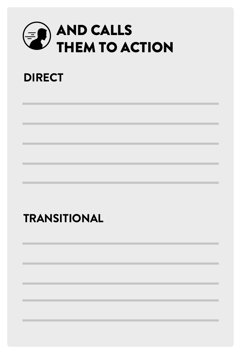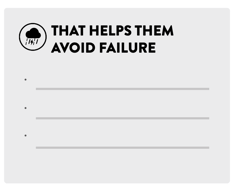How To Clarify Your Marketing So Your Ideal Clients Will Listen
Share this
In a 1999 Harvard University study, psychologists Daniel Simons and Christopher Chabris asked participants to watch a short video showing six people—three wearing white shirts and three wearing black shirts—passing basketballs to each other. Participants were tasked with keeping track of the number of passes made by the people wearing white shirts. Eventually, a person in a gorilla costume walks into the middle of the frame, faces the camera and thumps their chest, and then leaves, spending nine seconds total on screen. The results, which cemented the study as one of the most well-known in the field, revealed that half of the participants never noticed the gorilla.
The study dramatically illustrates what is called inattentional blindness—the failure to perceive things we don’t pay attention to. Because we have limited cognitive resources, subconscious filtering processes allow us to survive and navigate our busy, stimulating environment. Attention serves as this filter, blocking irrelevant information and focusing our brainpower on only the most essential things. Attention effectively filters out the background noise and protects our brain from being overwhelmed by the world. Half of the participants never noticed the gorilla because the gorilla never earned their attention; instead, their attention was on the ball, counting the number of passes.
What does this have to do with your marketing strategy? Donald Miller, author of Building a StoryBrand, would say everything. As a writer and a marketer, Miller speaks to the pivotal lessons he’s learned about attaining and maintaining an audience’s attention. Good marketing and good storytelling, as we’ll see, have more parallels than you’d imagine. In the book, Miller guides us towards understanding that good marketing and good storytelling can work together to create a compelling identity for your brand, helping you clarify your message so your ideal client pays attention and hears what you're saying, even in a world full of noise.
Survive, Thrive, and Be Part of a Community
What earns our attention, and what gets filtered out? We attend to the most essential things in our environment at any given moment. In Miller’s words, we are all scanning our environment for things that will help us survive, thrive, or be part of a community—all fundamental human desires. If something in our environment offers us information related to any of these desires, we pay attention.
To Miller, almost all marketing efforts are a waste of resources because of two fatal errors:
Mistake #1: Businesses fail to focus on the aspects of their offer that will help people survive and thrive
“Customers want to know where you can take them. Unless you clearly identify that you offer something they want, it’s unlikely they will listen.”
The goal of all of your marketing collateral is to win the attention of your ideal clients. If the gorilla study has a lesson for us here, it’s that if your marketing doesn't speak to what your ideal client cares about—surviving, thriving, or being part of a community—then they probably won't even notice it.
There's good news: as a financial advisor (and a fiduciary, fee-for-service one at that) your service offering allows your clients to survive and thrive directly. The success of your marketing efforts depends entirely on your ability to briefly (see below) communicate that with every single prospect who encounters your firm.
Mistake #2: Businesses cause customers to burn too many calories in trying to understand their offer
“If you confuse, you’ll lose.”
If any part of your marketing makes your prospects work too hard to understand what you have to offer, you’ll lose them—their attention is a limited and valuable resource after all, and our brain endeavors to save us as much energy (calories) as possible as we navigate our environment. It takes a lot of energy to parse through a bunch of noise, trying to figure out what is actually meaningful and relevant to us and our efforts to survive and thrive. That’s why hardly anyone does.
When a prospect visits your website for the first time, and they are met with information about who you are, when and why you started your firm, or even a large section listing the wide array of services you offer, understand that all of this—from a new prospect’s perspective—is textbook noise. Miller would say it’s not a matter of if they will tune you out, it’s a matter of how fast. It simply takes too much energy for them to filter through the noise and figure out if what you have to offer is something that will help them to survive and thrive.
So how can you communicate the information you need to without losing your audience's attention? Here’s where Miller introduces the power of storytelling—the secret weapon that will grow your business. He says that story is the most powerful tool we have to organize information so people don’t have to burn too many calories trying to understand it. But prospects aren’t interested in just any story—they are interested in theirs.
When prospects clearly and immediately understand how you can help them live a wonderful story, your firm will grow. So how can you position your message to touch on the things that your ideal client cares about and then turn that into marketing collateral that grabs their attention and doesn’t let it go? Enter the StoryBrand Framework.
The StoryBrand Framework
“Story is the greatest weapon we have to combat noise because it organizes information in such a way that people are compelled to listen.”
The StoryBrand Framework is the formula Miller lays out for clearer communication; this framework will help you clarify your message, get rid of noise, and use storytelling to make it all compelling. The framework consists of seven categories, and as Miller walks us through, you are to frame your own businesses within the lens of each category.
The result? You’ll end up with soundbites from each of the seven categories, effectively distilling your firm’s message onto one page. This page is called your StoryBrand Brandscript, and the rest of the book is dedicated to the process of filling out your own. Before we move on to the Brandscript, let’s take a look at each of the seven categories.
The Seven Elements of Great Storytelling
These seven elements make up the StoryBrand Framework and will be the basis of your Brandscript:
- A Character
- Has a Problem
- And Meets a Guide
- Who Gives Them a Plan
- And Calls Them to Action
- That Helps Them Avoid Failure
- That Ends in a Success
Image: Donald Miller, Building a StoryBrand
Miller shows us how the seven-part story framework holds up in almost every story you’ll encounter. Here’s Star Wars as an example:
Image: Donald Miller, Building a StoryBrand
As you fill out your Brandscript, you will identify each of these storytelling elements in relation to your firm. By crafting your message in story form and making the story about your ideal clients, your marketing will speak directly to what they are looking for to survive, thrive, or be part of a community—this is how you’ll earn their attention. When prospects finally understand how your services can help them live the story they dream about, your firm will grow.
To clarify your message and put it into story form that will help you do all of the above, Miller walks us through filling out the Brandscript. First, here are some instructions:
- Filter your message through the framework by filling out your Brandscript. Visit MyStoryBrand.com and fill it out there for free.
- Start with your firm as a whole. If you want, you can further break down your service offerings and fill out a Brandscript for each, but start with your entire firm first.
- Implement your Brandscript using the Marketing Roadmap outlined at the end of this post.
(If you're looking for more in-depth instructions, check out the book or audiobook.)
Let’s get started on your Brandscript.
Your StoryBrand Brandscript
“Your customer should be the hero of your story, not your brand. This is the secret every phenomenally successful business understands.”
Image: Donald Miller, Building a StoryBrand. Fill out your own Brandscript for free here.
A Character
The customer is the hero, not your brand.
Miller explains that a story doesn’t really pick up until the hero needs to disarm a bomb, defeat a villain, or fight for their emotional or physical survival. A story starts with a hero who wants something. And then the question becomes, “Will the hero get what she wants?” What is it that your ideal clients want in relation to your business? Unless you identify something they want, it’s unlikely they will listen.
Remember surviving, thriving, and being part of a community? Yep, you’ll need to choose a desire relevant to their survival. For our purposes here, survival considerations go far beyond food and shelter. Conservation of resources (money or time), building social networks and community, gaining social status, and the desire for meaning (less time working and more time living, perhaps) are all survival-related. As an advisor, you have a serious leg up when it comes to fulfilling a survival-related desire for your clients; your work is all about helping them thrive. Don’t waste a second letting them know this.
Here are some example desire statements:
The honest financial advice you've been looking for
A small business that can weather any potential storm
Helping you spend more time living and less time working
Spring into action: Brainstorm potential desires your ideal client may have that you can fulfill. Pare this down into a singular, specific focus.
Image: Donald Miller, Building a StoryBrand
Has a Problem
Companies tend to sell solutions to external problems, but customers buy solutions to internal problems.
The more we identify and talk about your ideal client’s problems, the more interest they will have in your services. Here’s how to talk about your ideal client’s problems.
Every story needs a villain—villains give conflict a point of focus. Position your services as weapons your ideal clients can use to defeat a dastardly villain. It doesn’t have to be a person but the villain should have personified characteristics. (Perhaps a 9-5 “stealing away time” your ideal client would otherwise spend with their family.)
There are three levels of conflict caused by a villain, and you’ll identify each:
- External
- Internal
- Philosophical
You should aim to solve external, internal, and philosophical problems for your clients whenever they engage your business. Here are some examples:
Tesla
Villain: Gas guzzling inferior technology
External: I need a car
Internal: I want to be an early adopter of new technology
Philosophical: My choice of car ought to help save the environment
Fee-for-service Financial Advisor
Villain: Commission-based advisors
External: I need investment and savings help
Internal: I am confused about what is sound financial advice I can actually trust given all the sales-driven advisors out there
Philosophical: If I am going to seek financial advice, I deserve an advisor who will listen to my goals and not try to sell me anything
What challenges are you helping your clients overcome? Keep it simple and straightforward.
Spring into action: Brainstorm all the literal and metaphorical villains your ideal client faces. Brainstorm external problems your brand solves. Brainstorm the internal problem, frustration, or doubt your ideal client feels as it relates to your brand. Is there a philosophical wrong your brand stands against?

Image: Donald Miller, Building a StoryBrand
And Meets a Guide
Customers aren’t looking for another hero; they’re looking for a guide.
Two main characteristics make for a great guide:
1. Empathy
Demonstrating empathy will let your ideal clients know you understand their pain and frustration. A bond of trust is created when someone feels known and understood by you. Good ways to show empathy are by making statements such as, “Like you, we are frustrated by...” or, “No one should have to…” Once you identify an internal problem, you need to let your ideal client know you understand and have found a resolution.
2. Authority
While nobody likes to be preached at, demonstrating authority really just means showing your competence and experience. How can you express authority without positioning yourself as the hero? Here are a few ideas:
-
- Testimonials (three is plenty, and keep them brief)
- Awards
- Statistics
- Logos from publications you’ve been featured in
Once you demonstrate empathy and authority, you position yourself as the ultimate guide for your hero.
Spring into action: Brainstorm empathetic statements you could say so prospects know you care about their internal problem. Then, brainstorm the ways you can demonstrate competence and authority.

Image: Donald Miller, Building a StoryBrand
Who Gives Them a Plan
Customers trust a guide who gives them a plan.
Making a plan for your prospects is basically identifying stepping stones you can place in the creek to alleviate fears and hesitancy. These stones will help them cross the creek and decide to engage with you. The plan either creates clarity about how someone can do business with you (process plan) or removes the sense of risk somebody might be feeling about signing on as a client (agreement plan).
The best process plans to use here have 3-4 steps and aim to simplify your customer’s journey and alleviate confusion. Here’s an example process plan you could feature in your marketing:
- Schedule a completely free consultation
- Allow us to create a customized plan
- We'll execute that plan together and realize your dreams
An agreement plan is a list of agreements you make to your clients to overcome their fear of doing business with you. The best way to arrive at an agreement plan is to list all the things your customer might be concerned about as it relates to your service or product and then counter that list with agreements that will alleviate their fears. Here's an example agreement plan:
- As a fiduciary, we'll always provide honest advice
- You can leave with all your assets at any time
- We operate with an affordable monthly retainer model with zero hidden costs or fees
Spring into action: What fears do your prospects have in relation to signing on as a client? What agreements could you make with them that would alleviate those fears? Make a 3–4 step plan.

Image: Donald Miller, Building a StoryBrand
And Calls Them to Action
Customers do not take action unless they are challenged to take action.
Unless you clearly invite prospects to take a journey with you, they won’t. Miller explains there should be a “schedule now” button on every webpage (and multiple times on your main page). This is your direct call to action, and it should be as clear as day.
The other type of call to action is a transitional one. A good transitional call to action can do three powerful things for your brand: demonstrate knowledge and authority, create reciprocity, and position yourself as a guide. Free PDFs, educational videos, podcasts, webinars, and, in normal times, live events are all great transitional calls to action.
Miller explains you want both types of calls to action in your marketing materials—meeting different prospects where they are. Is there a transitional call to action you can use to grow your business? Are your direct calls to action clear and repeated often? Having clear calls to action means prospects aren’t confused about the steps they need to take to do business with you.
Spring into action: Decide what direct call to action you want to make obvious on all of your marketing material and brainstorm transitional calls to action.

Image: Donald Miller, Building a StoryBrand
That Helps Them Avoid Failure
Every human being is trying to avoid a tragic ending.
A story without stakes is boring. Miller asks us to define what’s at stake for the heroes in your story, your ideal clients. What are the potential pitfalls of not doing business with you? While it’s true that fear-mongers don’t do well in the marketplace, Miller posits that fear-mongering is not the problem that 99% of business owners have. Moderate amounts of fear are actually incredibly effective and provide your ideal clients with the stakes that make the story interesting and meaningful.
What are you helping your clients avoid? What are the costs of not doing business with you? As an advisor, here are some examples:
-
- Confusion about meeting your financial goals
- Not being ready for retirement
- A lack of transparency from your financial advisor
- A lack of one-on-one interaction with your advisor
- Hidden fees and product sales
You might say something like this:
“Don’t postpone your retirement. You’ve worked too hard for too long to not enjoy time with your family.”
“As an entrepreneur, you need to know how you can secure your business to weather a potential storm.”
Including these ideas in your marketing material will give your story an overall sense of completeness and urgency—you’ve included stakes in the narrative.
Spring into action: Brainstorm the negative consequences you are helping your clients avoid and write down at least three.

Image: Donald Miller, Building a StoryBrand
And Ends in Success
Never assume people understand how your brand can change their lives. Tell them.
Miller urges us never to assume prospects understand how your services and advice can change their lives—instead, you need to tell them simply and clearly. Without knowing it, every potential client you meet is asking you where you can take them. Like successful leaders, successful brands make it clear what life will look like if somebody engages their products or services.
The next step is to say it clearly; you must tell your potential clients what their lives will look like after they engage with you and your services, or they will have no motivation to do so. A story has to go somewhere. Once you know how your client’s life will change after they engage your services, you will have plenty of copy to use in your marketing collateral.
What problem are you resolving in your client's life, and what does that resolution look like? Stick to basic answers because basic answers really do work.
Spring into action: Brainstorm the successful resolution you’re helping your clients achieve. What will their lives look like if they engage with you and your services?

Image: Donald Miller, Building a StoryBrand
People Want Your Brand to Participate in Their Transformation
Brands that realize their customers are human, filled with emotion, driven to transform, and in need of help truly do more than sell products; they change people.
The last element to your Brandscript isn’t one of the seven elements of a great story; rather, it’s the end result. As Miller explains, the human desire to transform is universal. Your firm and your services are helping people become better versions of themselves. You offer your clients your services, and they engage with you because you are participating in their transformation, and they want you to do so.
Who does your prospect want to be? What kind of person do they want to be? What is their aspirational identity? Miller offers the advice that the best way to identify an aspirational identity that your clients may be attracted to is to consider how they want their friends to talk about them. Once you know who your clients want to be, you will have language to use in emails, blog posts, and all manner of marketing material.
Who does your customer want to become as they relate to your advice and services? Here’s a potential example:
From: Confused and ill-equipped when it comes to financial strategy
To: Confident and informed about their financial plan as it relates to their long-term goals
Spring into action: Brainstorm the aspirational identity of your customer. Who do they want to become? How do they want to be perceived by others?

Image: Donald Miller, Building a StoryBrand
Implementing Your StoryBrand Brandscript
Who says you aren’t a great storyteller? Now that you’ve filled out your Brandscript, you have simplified your message and have the foundations of a compelling story your ideal clients will relate to and will jump to be a part of, because it’s their story—you’ve inserted your firm and your offerings into the story that they want to live. Now, it’s time to make sure they know about it.
The soundbites from the Brandscript you have put together have to show up on your website, in email campaigns, elevator pitches, and sales scripts. Miller says the degree that you implement your brand script is the degree to which people will understand why they need your services. The more you implement, the clearer your message will become, and the more prospects will pay attention to you amidst the noise of the world. He offers a plan to implement the story you have woven, starting with your website.
Building a Better Website
As an advisor, your website is almost certainly the first point of contact that prospects will have with your firm—it needs to be concise and compelling. Within the first five seconds of a prospect visiting your website, can they tell you what you offer, how it relates to what they want, and how to do business with you? If not, you will likely fail to grab their attention, and your message will be lost.
Miller offers five things your website should include. The easy part? You already have the Brandscript, and all you have to do is stay on script. He explains that there shouldn’t be a single word, image, or idea that doesn’t come from the thoughts generated by your StoryBrand Brandscript. Here are the five must-have website elements:
- Offer above the fold
- Anything "above the fold" refers to the images and text visible before you start scrolling down your site. Your copy here needs to be short, enticing, and exclusively client-centric. Your prospects need to know what’s in it for them—keep it bold and short.
- Obvious calls to action
- Your direct CTA should be the most obvious button on your home page and all of your pages, really. Include it in the top right and also in the center of the screen (above the fold). Your transitional CTA should also be obvious, but don’t let it distract from your direct one. Use less bold colors, perhaps.
- Images of success
- This one seems fairly simple, but as we know, there is power in simplicity. Images of smiling and happy people go a long way in communicating the type of story ending you offer your clients when they engage with your services. Photos of smiling people speak to us and represent an emotional destination we'd like to head toward.
- A bite-sized breakdown of your offerings
- You need to communicate succinctly about what you do, but what if you offer a wide variety of services and different types of advice? Miller encourages you to find an umbrella statement that unifies them all. Once you have the unified statement of what you offer, you can then separate your offerings out using different pages on your site. (You can fill out another Brandscript for each offering).
- Very few words
- People very seldom read websites—they scan them. Miller promises that if you have a paragraph above the fold on your site, it’s being passed over. He says some of the most effective websites he's reviewed have used ten sentences or less on the entire page. Long sections of text are fine and perhaps necessary, but the key is to use a “read more” link at the end of a brief sentence leading to another page so people can expand if they like, but aren't bombarded and filter you out.
The StoryBrand Marketing Roadmap
In his closing piece of advice, Miller offers five (almost free) things you can do to implement the StoryBrand Framework and grow your business. Here they are:
- Create a one-liner
- A clear and compelling one-liner will intrigue qualified prospects to engage with you and your services and is a great way to spread the word about what you do. It doesn’t need to be one sentence, or four. Think of it more as a statement. Here’s the four-part formula for a compelling one-liner:
- Character - People should be able to say, “That’s me!” as you clearly identify them.
- Problem - Stating the problem your prospects are facing opens the story.
- Plan - Hint at your plan. prospects should think, “Well, when it’s put that way, it makes sense.”
- Success - Paint a picture of what life could look like after they engage your business.
- Here’s an example: “We provide busy tech professionals with simple, practical financial advice they can use to gain more freedom.”
- Create a lead generator and collect email addresses
- You need a lead generator—you need a PDF, e-course, video series, webinar, live event, or just about anything else that will allow you to collect email addresses. A lead generator will help you find qualified buyers so you can let them know, directly and authoritatively, how you can help them resolve their problems.
- Create an automated email campaign
- Content is important, but there is also great power in simply reminding your prospects you exist. Here’s a simple formula Miller provides for effective and concise email copy:
- Nurturing email:
- Talk about a problem
- Explain a plan to solve the problem
- Describe how life can look for the reader when the problem is solved
- He recommends sending three nurturing emails and then one with a CTA and offer, then repeat the cycle. Your call to action and offer email should also aim to solve a problem. Weave in your Brandscript—external problem, internal fear, and elements from the success module.
- Collect and tell stories of transformation
- Almost every story is about the transformation of a hero, and past clients' stories help prospects immediately understand what you can offer them. Don’t underestimate the power of a great testimonial. Having a handful at the ready will give you easy and meaningful content.
- Create a system that generates referrals
- Once you deliver a phenomenal client experience, the next step is to invite your clients to become evangelists for your brand. Miller explains that this won’t usually happen organically, and the best approach is to create a system that invites and incentivizes your clients to spread the word. You’d be surprised how willing thrilled clients may be to share your message after a simple ask—it’s a great story to tell, after all.
You operate a business within a busy world, full of noise, and your success depends on your ability to cut through the noise and earn the attention of your ideal clients. Even if you're wearing a gorilla costume and thumping your chest in the middle of the frame, you have no platform unless you can earn the attention of your ideal clients by speaking to the story that they care about—their own—and positioning your offering directly in relation to what they desire. What Donald Miller has demonstrated for us in Building a StoryBrand is the power of strategic storytelling and brevity. You need to harness both to thrive.
He leaves us with this:
“Marketing has changed. Businesses that invite their customers into a heroic story grow. Businesses that don’t are forgotten. May we all be richly rewarded for putting our customers’ stories before our own.”
.png?width=312&name=Untitled%20design%20(5).png)
About Emily Campbell
Emily Campbell is Associate Editor on XYPN's Marketing Team. She is passionate about language and writing, swoons over an illustrative alliteration, and she can't believe she gets the opportunity to communicate with the world about the XYPN movement. When she's not looking for her next chance to use an em dash, she spends her time with her rescued pit bull named Dog, coexists with spiders as an extension of her vegan values, and engages with the (mostly dead) philosophers that live in her head.
Share this
- Fee-only advisor (381)
- Advice (305)
- Business Development (248)
- Independent Financial Advisor (203)
- Growing Your Firm (161)
- Marketing (133)
- Financial Planning (129)
- What Would Arlene Say (WWAS) (81)
- Business Coach (80)
- Firm Ownership (78)
- Training (75)
- Compliance (72)
- Business (69)
- Building Your Firm (65)
- Financial Advisors (63)
- Online Marketing (61)
- Events (59)
- Starting a Firm (52)
- Staffing & HR (49)
- Technology (49)
- From XYPN Members (48)
- Launching a firm (46)
- Advisors (41)
- Entrepreneurship (38)
- Taxes (37)
- Networking & Community (33)
- Interviews and Case Studies (32)
- Investment Management (31)
- Sales (27)
- Social Responsibility (27)
- Tax Preparation (27)
- XYPN Invest (26)
- Business Owner (25)
- Small Business Owner (20)
- Financial Management & Investment (19)
- Industry Trends & Insights (19)
- Financial Education (17)
- Financial Planners (17)
- Independent Financial Planner (17)
- Tech Stack (17)
- XYPN (17)
- Leadership & Vision (16)
- Investing (15)
- Niche (15)
- How to be a Financial Advisor (14)
- NextGen (14)
- RIA (14)
- Media (13)
- Preparing to Launch (13)
- Press Mentions (13)
- RIA Operations (12)
- RIA Owner (12)
- XYPN Membership (12)
- Assets Under Management (AUM) (11)
- First Year (11)
- Goals (11)
- Scaling (10)
- Advisor Success (9)
- Building Your Firm (8)
- Communication (8)
- Lessons (8)
- Study Group (8)
- Time Management (8)
- Virtual Advisor (8)
- Behavioral Finance (7)
- Growth (7)
- Pricing Models (7)
- From Our Advisors (6)
- Independent RIA (6)
- Money Management (6)
- Motivation (6)
- Processes (6)
- Automation (5)
- Broker-Dealers (5)
- College Planning (5)
- Filing Status (5)
- How I Did It series (5)
- Investment Planner (5)
- Mental Health (5)
- Michael Kitces (5)
- Preparing to Launch (5)
- RIA Operations (5)
- Retirement (5)
- Risk and Investing (5)
- S Corpration (5)
- Support System (5)
- TAMP (5)
- Wealth (5)
- Year-End (5)
- Client Services (4)
- Outsourcing (4)
- Selling a Firm (4)
- Succession Plans (4)
- Benchmarking Study (3)
- Budgeting (3)
- Career Changers (3)
- Engagement (3)
- Fiduciary (3)
- Getting Leads (3)
- Membership (3)
- Millennials (3)
- Monthly Retainer Model (3)
- Partnership (3)
- Pricing (3)
- Recordkeeping (3)
- Risk Assessment (3)
- Small Business (3)
- Staying Relevant (3)
- Work Life Balance (3)
- Advice-Only Planning (2)
- Bookkeeping (2)
- Charitable Donations (2)
- Client Acquisition (2)
- Differentiation (2)
- Health Care (2)
- IRA (2)
- Inflation (2)
- Productivity (2)
- Implementing (1)
Subscribe by email
You May Also Like
These Related Stories

Four (Doable) Ways to Dramatically Improve Your RIA's Website

Craft a Compelling Value Proposition in 6 Steps (Template Included)



